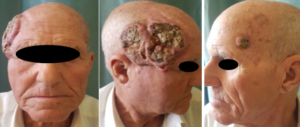Oukarfi Sara1*, Baybay H1, Douhi Z1, Elloudi S1, Mernissi FZ1
1- Department of Dermatology and Venerology, Hospital University Hassan II, Fez Morocco
*Corresponding Author: Sara Oukarfi, Department of Dermatology and Venerology, Hospital University Hassan II, Fez Morocco; Email: [email protected]
Published Date: 15-08-2020
Copyright© 2020 by Oukarfi S, et al. All rights reserved. This is an open access article distributed under the terms of the Creative Commons Attribution License, which permits unrestricted use, distribution, and reproduction in any medium, provided the original author and source are credited.
Dear Readers,
Let me present the case of Mr H. aged 70, farmer, with notion of sun exposure since childhood. Who presents in consultation for a neglected right temporal tumor evolving for 18 months with another contralateral tumor of the same aspect evolving for 5 months.
Dermatological examination showed two contralateral temporal tumors, the largest measuring approximately 10 cm from long axis to the right and 3 cm to the left.
On the right the tumor is bilobed, well limited, of irregular contours, ulcerated with raised edges and budding bottom surmounted by fibrin and hemorrhagic crusts, fixed with pain on palpation. On the left, the tumor is small with the same clinical appearance.
We noticed an aspect of heliodermia made of several actinic keratoses of the scalp with a rhomboid neck. The lymph nodes were free (Fig. 1).
Figure 1: Bilateral temporal squamous cell carcinoma.
Histological examination of the biopsies revealed a well differentiated mature and infiltrating epidermal carcinoma for the two tumors.
The patient underwent a cerebro-cervical CT scan, then was operated on with a reconstruction for the large tumor. Cryotherapy treatment has been started for actinic keratoses with optimal photo protection.
Squamous Cell Carcinomas (SCCs) are primary skin malignant epithelial tumors which differ from basal cell carcinomas by their metastatic potential [1]. Most SCCs are found in exposed regions exposed to the sun: the face and the back of the hand.
Among tumors of the scalp, 16.6% are squamous cell carcinoma, making SCC the second most prevalent, after basal cell carcinoma [2]. In addition to increased age, risk factors for scalp SCC include chronic scarring, actinic damage, and a history of ionizing radiation [3]. Actinic damage, combined with androgenetic alopecia, may explain the slight increased risk of scalp SCC among men, as compared to women [2].
The clinical diagnosis is often obvious. The lesion most often appears on abnormal skin and variably combines 3 components: budding, ulceration and infiltration. The ulcerative form is the most frequent, but histological confirmation is essential before placing the indication for a large excision. The standard treatment for squamous cell carcinomas is surgical excision. The purpose is to avoid recurrences, whether local, regional or remote.
Extensive facial localizations, with invasion of several esthetic units, as in the case of our patients, pose problems for surgeons given the morphological and functional sequelae inherent in carcinological excision and the difficulty of obtaining a satisfactory repair.
In case of neglect, like our patient, SCC of the face and scalp can lead to disastrous aesthetic and social consequences, hence the importance of early diagnosis and prevention of precancerous lesions through physical and chemical photoprotection.
Keywords
Squamous Cell Carcinoma; Scalp; Surgery
Reference
- Marur S, Forastiere AA. Head and neck squamous cell carcinoma: update on epidemiology, diagnosis, and treatment. Mayo Clin Proceedings 2016;91(3):386-96.
- Handler MZ, Goldberg DJ. Cutaneous squamous cell carcinoma of the scalp extending to the skull: A case report and review of the literature. J Cosmet Dermatol. 2018;17:232-4.
- Lang PG Jr, Braun MA, Kwatra R. Aggressive squamous carcinomas of the scalp. Dermatol Surg. 2006;32:1163-70.08
Article Type
Letter to Editor
Publication History
Received Date: 30-05-2020
Accepted Date: 08-08-2020
Published Date: 15-08-2020
Copyright© 2020 by Oukarfi S, et al. All rights reserved. This is an open access article distributed under the terms of the Creative Commons Attribution License, which permits unrestricted use, distribution, and reproduction in any medium, provided the original author and source are credited.
Citation: Oukarfi S, et al. Bilateral Squamous Cell Carcinoma of the Forehead. J Dermatol Res. 2020;1(2):1-2.

Figure 1: Bilateral temporal squamous cell carcinoma.


